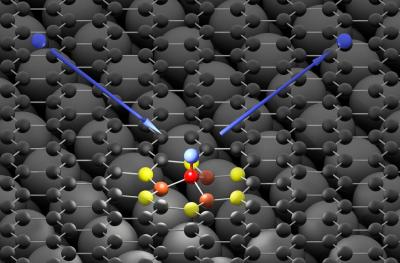Researchers from Göttingen and Pasadena (USA) have produced an "atomic scale movie" showing how hydrogen atoms chemically bind to graphene in one of the fastest reactions ever studied. The team found that by adhering hydrogen atoms to graphene, a bandgap can be formed.
 The hydrogen atom (blue) hits the graphene surface (black) and forms a bond with a carbon atom (red). The high energy of the hydrogen atom is first absorbed by neighboring carbon atoms (orange and yellow) and then passed on to the graphene as a sound wave
The hydrogen atom (blue) hits the graphene surface (black) and forms a bond with a carbon atom (red). The high energy of the hydrogen atom is first absorbed by neighboring carbon atoms (orange and yellow) and then passed on to the graphene as a sound wave
The research team bombarded graphene with hydrogen atoms. "The hydrogen atom behaved quite differently than we expected," says Alec Wodtke, head of the Department of Dynamics at Surfaces at the Max Planck Institute (MPI) for Biophysical Chemistry and professor at the Institute of Physical Chemistry at the University of Göttingen. "Instead of immediately flying away, the hydrogen atoms 'stick' briefly to the carbon atoms and then bounce off the surface. They form a transient chemical bond," Wodtke exclaims. Something else also surprised the scientists: The hydrogen atoms have a lot of energy before they hit the graphene, but not much left when they fly away. It seems that hydrogen atoms lose most of their energy on collision, but where it goes remained to be examined.
In order to explain these surprising experimental observations, the Göttingen MPI researcher Alexander Kandratsenka, in cooperation with colleagues at the California Institute of Technology, developed theoretical methods, which they simulated on the computer and then compared to their experiments. With these theoretical simulations, which agree well with the experimental observations, the researchers were able to reproduce the ultra-fast movements of atoms forming the transient chemical bond. "This bond lasts for only about ten femtoseconds - ten quadrillionths of a second. This makes it one of the fastest chemical reactions ever observed directly," Kandratsenka explains.
"During these ten femtoseconds, the hydrogen atom can transfer almost all its energy to the carbon atoms of the graphene and it triggers a sound wave that propagates outward from the point of the hydrogen atom impact over the graphene surface, much like a stone that falls into water and triggers a wave," says Kandratsenka. The sound wave contributes to the fact that the hydrogen atom can bind more easily to the carbon atom than the scientists had expected and previous models had predicted.
The results of the research team provide fundamentally new insights into chemical bonding and can be of great interest to industry; Sticking Hydrogen atoms to graphene can produce a bandgap, making it a useful semiconductor and much more versatile in electronics.
The team invested a great deal of effort in performing and running these experiments, according to Oliver Banermann, project group leader at the University of Göttingen. "We had to carry them out in ultra-high vacuum to keep the graphene surface perfectly clean." The scientists also had to use a large number of laser systems to prepare the hydrogen atoms before the experiment and to detect them after the collision.

